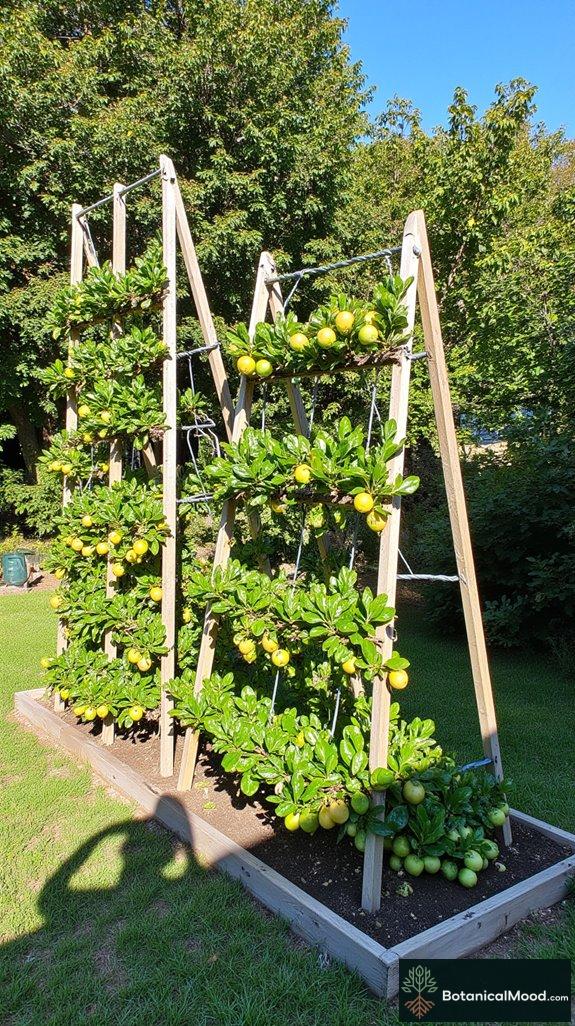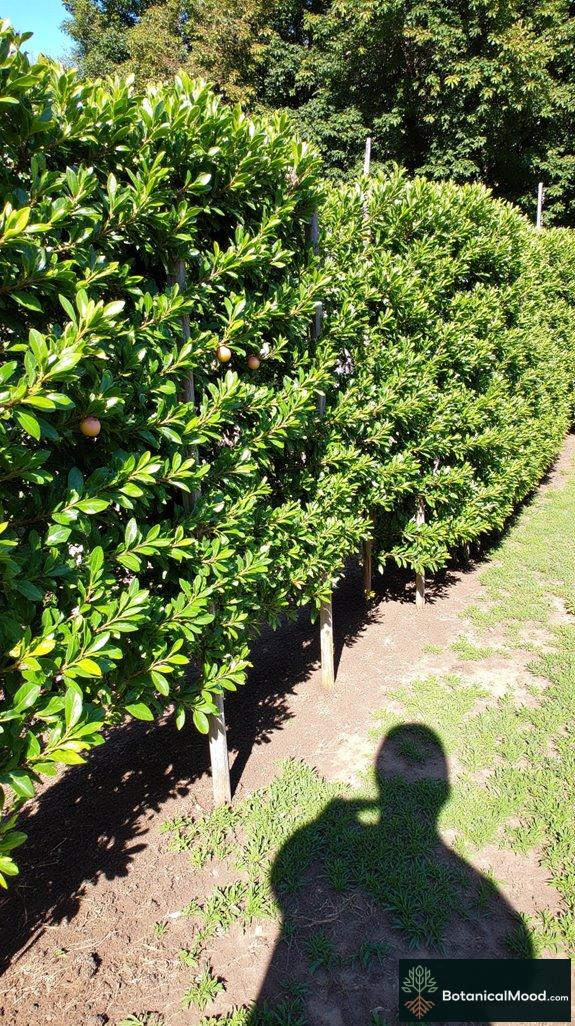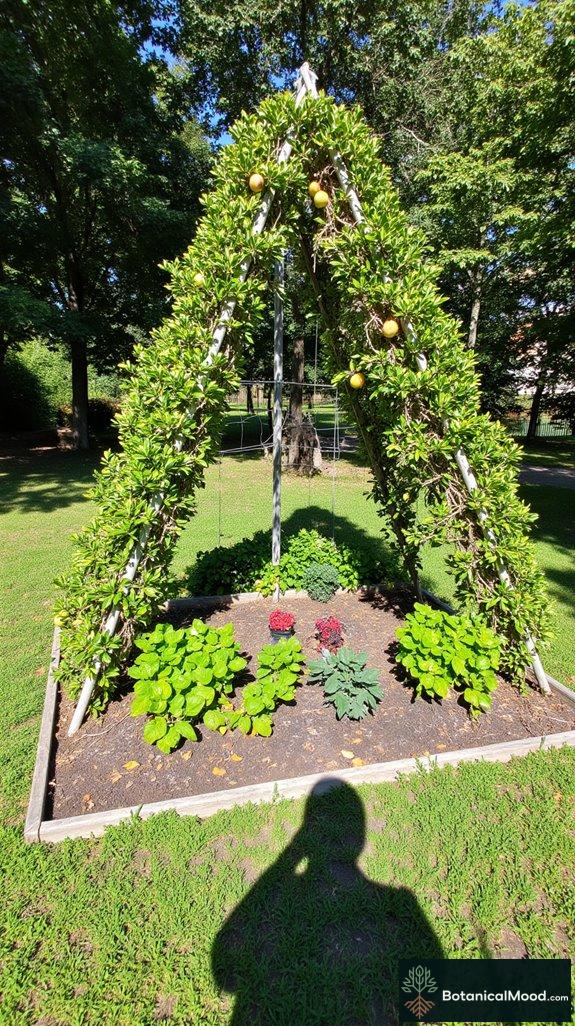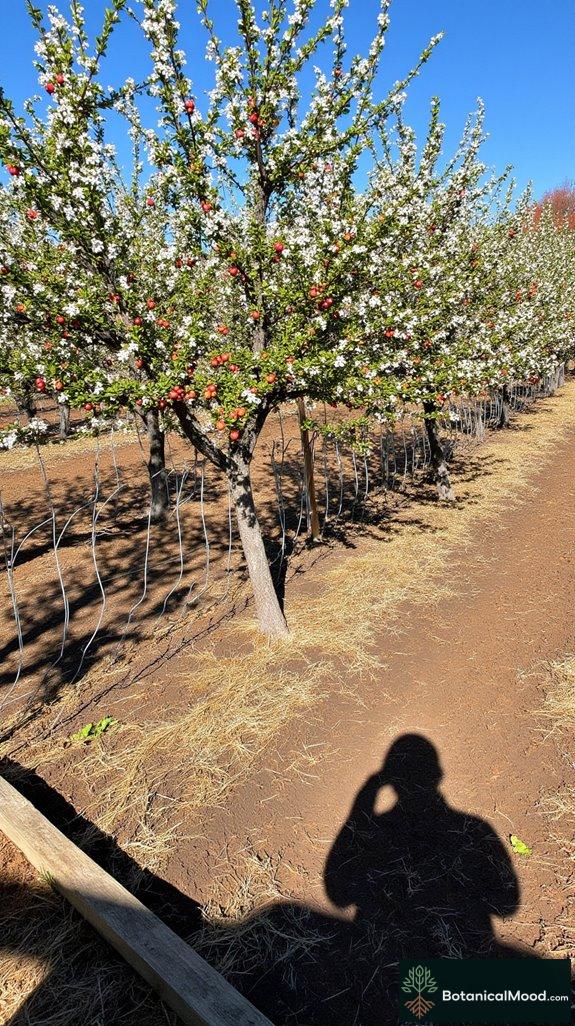Want to turn your tiny garden into a fruit-producing masterpiece? Let me tell you about my obsession with espalier designs.
I’ve spent countless hours (and killed a few innocent apple trees) perfecting these seven segmented patterns. Trust me, it’s been quite the journey from total disaster to Instagram-worthy garden walls.
The Classic Horizontal is my go-to for apples – though I once tried it with figs and created what I lovingly call “The Great Fig Catastrophe of 2019.” The Vertical Ladder? Perfect for those who think up, not out.
Fan-shaped designs bring drama (as if my garden needed more), while Triangles maximize every precious inch. Don’t get me started on U-Shaped and Zigzag patterns – they’re like garden architecture meets modern art.
How My Failed Wedding Arch Became a Thriving Espalier Wall
Remember that time I tried to create a romantic apple espalier arch for my sister’s garden wedding? Well, the wedding was a disaster (thanks, unexpected tornado), but that failed arch taught me everything about proper tensioning and support systems. Now it’s a stunning 12-foot Belgian fence pattern hosting six varieties of heritage apples. I’ve integrated companion planting with lavender and thyme beneath, creating a pollinator paradise. The key was using 2.5mm galvanized wire and proper spacing – 18 inches between horizontal tiers. Sometimes the best garden designs come from our biggest failures.
Quick Takeaways
- Classic Horizontal Espalier maximizes small space with structured rows, ideal for apples and pears, requiring regular pruning for maintenance.
- Vertical Ladder Espalier utilizes closely spaced supports, perfect for compact growth of apple and pear trees in limited vertical spaces.
- Fan-Shaped Espalier offers a dynamic growth pattern, accommodating multiple plants with ample light exposure in a compact garden setting.
- Triangle Espalier efficiently uses space with dwarf fruit varieties, promoting air circulation and light penetration while maintaining an attractive design.
- U-Shaped Espalier bed supports a multitude of fruits, ensuring equal spacing and nutrient-rich soil, which is well-suited for small gardens.
Classic Horizontal Espalier Design

Classic Horizontal Espalier Design
Classic Horizontal Espalier is a highly structured planting bed ideal for small spaces, creating an aesthetically pleasing garden feature.
Typically, it spans a length of 4-6 feet, with the plants arranged in horizontal rows for visual balance. Commonly used plants include apples, pears, and figs, supported by wooden trellising or wire for minimalist elegance.
Constructing this design involves planting young trees next to a sturdy framework positioned against a wall or fence while periodically pruning the branches to maintain their horizontal growth. This design embodies principles of sustainable permaculture by maximizing vertical space while providing fruit production.
Selecting Plants for Classic Espalier
When choosing plants for a horizontal espalier design, consider these factors:
- Plant Size: Choose dwarf or semi-dwarf varieties.
- Climate Compatibility: Select plants suited for your local climate.
- Pollination Needs: Include compatible pollinators if needed.
Recommended plants:
- Apple (Malus domestica)
- Pear (Pyrus communis)
- Plum (Prunus domestica)
- Fig (Ficus carica)
Designing Your Espalier Planting Bed
To design an effective horizontal espalier planting bed, focus on these essential steps:
- Choose the Right Location: Verify ample sunlight (6-8 hours daily).
- Plan Spacing: Space plants 2-3 feet apart for ideal growth.
- Layout Design: Use the “T” or “U” shape for dynamic structure.
- Stake and Support: Install a robust trellis or wire support beforehand.
Pro Tips:
- Prune regularly to encourage horizontal growth.
- Use garden ties to secure branches as they bend to shape.
Understanding Plant Care Needs
To promote successful growth in your espalier, learn about specific care protocols, including watering frequencies, soil preferences, and pest management techniques.
Regular upkeep contributes to a healthy, well-structured garden. Recall, proper light exposure and timely pruning can greatly enhance fruit yield and aesthetic appeal.
Vertical Ladder Espalier Configuration

Vertical Ladder Espalier Configuration
The Vertical Ladder Espalier Configuration is an aesthetically pleasing planting bed that’s ideal for compact orchards. Typically measuring 6-8 feet in height and 3-4 feet in width, this design features closely spaced horizontal supports resembling a ladder, allowing plants to grow up and along the framework. Modular garden design can enhance the efficiency and organization of your orchard setup.
Common materials include sturdy wood or metal for the frame, and planting spaces can accommodate apple, pear, or fig trees which are perfectly suited for this technique. Constructing this espalier includes securing the frame to a wall or fence, guaranteeing stability while allowing sufficient sunlight for your plants.
How to Select Plants for This Bed
When choosing plants for your vertical ladder espalier, consider their growth habits and suitability for compact spaces. Suggested plants include:
- Apple trees (Malus domestica)
- Pear trees (Pyrus communis)
- Fig trees (Ficus carica)
Designing a Vertical Ladder Planting Bed
To design your vertical ladder espalier, follow these tips for an effective layout:
- Sketch your space to visualize dimensions and placements.
- Plan for proper spacing of 18-24 inches between plants for air circulation.
- Install supports at every 2-3 feet vertical interval for plant training.
- Pro tip: Regular pruning will help maintain the desired shape and encourage new growth.
Maintaining Your Espalier Garden
Maintaining your vertical ladder espalier is key for a thriving garden. Regular watering, mulching, and fertilizing will encourage healthy growth.
Monitor for pests and diseases to guarantee your plants remain robust. Fertilization every spring supports productive harvests, guaranteeing your compact orchard flourishes and yields plentiful fruit throughout the season.
Fan-Shaped Espalier Arrangement

The fan-shaped espalier arrangement is an elegant option for compact orchards, showcasing a stunning visual display. Typically, planting beds measure around 3 to 4 feet wide and can stretch from 6 to 12 feet in length. This design features a series of trees or shrubs trained to grow in a fan shape against a wall or trellis, creating an eye-catching vertical garden.
Suitable plants include apple, pear, and ornamental cherry trees, all of which thrive in this setup. Use materials like sturdy trellises or wire to support the plants, construct the bed using well-draining soil, and amending the soil with compost for maximum growth. Additionally, incorporating an effective irrigation system can significantly enhance plant vitality and fruit production.
Selecting Plants for Fan-Shaped Espalier
To select plants for your fan-shaped espalier arrangement, consider the following:
- Apple Trees (e.g., ‘Espalier Spindle’ varieties)
- Pear Trees (‘Bartlett’ and ‘Bosc’ are ideal)
- Cherry Trees (ornamental types like ‘Sakura’)
- Plum Trees (such as ‘Damson’)
- Fig Trees (compact varieties like ‘Petite Negra’)
Ensure the plants are disease-resistant and suited to your climate zone.
Designing a Fan-Shaped Espalier Arrangement
To design and plan your fan-shaped espalier arrangement, follow these tips:
- Choose a Location: Select a sunny spot, ideally with south or west exposure.
- Spacing: Space trees about 2-3 feet apart to allow for air circulation.
- Trimming: Regularly prune to maintain the fan shape and remove excess growth.
- Support: Install a wire system at intervals (6-12 inches) for guiding growth.
- Growth Direction: Train branches to extend outward rather than upward.
Utilizing these tips will enhance plant health and visual appeal, making your orchard delightful.
Maintaining Healthy Orchards Long-Term
Caring for a compact orchard requires consistent attention. Regularly check for pests, apply mulch for moisture retention, and use organic fertilizers to encourage robust fruiting.
Stay informed on seasonal care routines and adjust watering schedules accordingly.
Columnar Espalier System

Columnar espalier systems are compact, vertical planting beds ideal for small spaces. Typically measuring 3-4 feet wide and up to 8 feet tall, these beds utilize a trellis or support structure for training plants. Common materials include treated wood, metal, or PVC pipes for stability. The arrangement features tiered layers, allowing for maximum sun exposure and air circulation. This bed style is particularly suited for fruit trees such as apples, pears, or plums, which can be pruned to maintain their shape and health while offering delicious harvests. Additionally, divided espalier planting beds contribute to efficient space management while allowing for a visually appealing arrangement of trees.
How to Select Plants for Columnar Espalier Beds
When choosing plants for your columnar espalier, consider varieties that naturally grow upright and can be easily trained. Here are some excellent options:
- Apple trees (e.g., ‘Columnar Joan J’)
- Pear trees (e.g., ‘Colonel’)
- Cherry trees (e.g., ‘Stella’)
- Plum trees (e.g., ‘Black Ice’)
Designing a Columnar Espalier Planting Bed
To effectively design your columnar espalier planting bed, follow these tips:
- Choose a sunny location with well-draining soil.
- Plan a trellis system at least 7-8 feet tall.
- Space trees about 2-3 feet apart to allow for growth.
- Maintain a consistent width of around 3-4 feet.
Pro tips: Use vertical growth supports like wires or grids to guide branches. Regular pruning is essential for maintaining shape and promoting new growth.
Exploring Vertical Gardening Techniques
Vertical gardening techniques can enhance your garden’s aesthetics while optimizing space. Consider integrating climbing plants such as peas, beans, or cucumbers with your columnar espaliers. They provide a lovely contrast while maximizing your harvest yield in limited areas. Incorporating these functional designs invites diversity and beauty, enriching your gardening experience.
Triangle Espalier Formation

The Triangle Espalier Formation is a creative planting bed that efficiently utilizes space for compact orchards. This design typically spans 4-6 feet in height and can extend 6-8 feet wide, creating a distinctive triangular shape. Constructed using sturdy materials like treated wood or metal for the support structure, this formation enables plants to grow vertically while preserving space.
The Triangle Espalier Formation is a space-efficient design for compact orchards, allowing vertical plant growth in a unique triangular shape.
Ideally, dwarf fruit trees or small fruit-bearing plants such as apples, pears, or figs are used, intertwined along the support framework.
Selecting Plants for Triangle Espalier
Choosing the right plants for your triangle espalier is crucial. Focus on dwarf varieties that fit well within the space constraints. Suggested plants include:
- Dwarf Apple Trees (e.g., ‘Honeycrisp’)
- Dwarf Pear Trees (e.g., ‘Buerre Hardy’)
- Fig Trees (e.g., ‘Petite Negra’)
- Blueberries (patio varieties)
- Raspberries (compact types)
Designing a Triangle Espalier Arrangement
To design your triangle espalier:
- Plan a stable triangular frame made of strong posts or wire.
- Position your chosen plants at the bottom, leaving adequate space, usually 3-4 feet apart to promote healthy growth.
- Guide branches along the frame as they grow.
- Pro Tips: Use pruning to maintain shape, facilitate sunlight penetration, and encourage lateral growth along the structure.
Understanding Espalier Techniques
Exploring espalier techniques allows you to maximize space and improve fruit production. By mastering basic training and pruning methods, you can create visually appealing designs while promoting healthy trees and abundant harvests.
The art of shaping can also enhance air circulation and light penetration, benefiting your compact orchard.
U-Shaped Espalier Setup

A U-shaped espalier setup is a compact planting bed ideal for small gardens and limited spaces. Typically, this design features a bed measuring about 4-6 feet wide and 8-10 feet long. The arrangement allows for vertical growth along sturdy trellises, maximizing sunlight exposure. Constructed using treated wood or metal for durability, the frame can be filled with well-draining soil, guaranteeing healthy root growth. Popular plants include dwarf fruit trees, such as apples, pears, and cherries, which thrive in this structured form.
Selecting Plants for Your U-Shaped Bed
When choosing plants for your U-shaped espalier bed, consider the following:
- Fruit Trees: Dwarf apple, pear, or peach trees.
- Vining Plants: Grape or kiwi for added vertical interest.
- Herbs: Basil or thyme for fragrant fillers.
- Flowers: Climbing roses for colorful accents.
Designing Your U-Shaped Planting Bed
Designing a U-shaped espalier bed involves careful planning and spacing. Here are some tips:
- Plan Layout: Sketch your design, guaranteeing equal spacing between each plant (about 18-24 inches apart).
- Vertical Structure: Use sturdy trellises to support the vertical growth of the espalier plants.
- Soil Quality: Amend soil with compost to promote nutrient retention and drainage.
- Regular Pruning: Guarantee plant growth is directed along the structure, fostering an attractive appearance.
Exploring Vertical Gardening Concepts
Vertical gardening can be a wonderful way to enhance your gardening space. This innovative approach allows you to cultivate more plants by utilizing vertical surfaces like walls and trellises.
With varied plant selections, including succulents and flowering vines, you can create a vibrant, enticing garden that thrives in the air rather than on the ground.
Zigzag Espalier Pattern

The Zigzag Espalier Pattern is a stunning and compact planting bed ideal for maximizing limited spaces in orchards or gardens. Typically constructed in a triangular frame, this pattern allows for a unique arrangement that creates visual interest.
Generally, the planting bed measures around 6-8 feet in width and can extend as long as desired. Wood, wire trellises, or lattice can be used to support the branches while maintaining the zigzag design. Popular plants include apple, pear, and cherry trees, which lend themselves well to this aesthetic since they’re often pruned for peak growth and fruit production.
Selecting Plants for Your Zigzag Bed
When choosing plants for your zigzag espalier bed, consider those with manageable growth habits and beautiful blossoms. Suggested plants include:
- Apple trees (Malus domestica)
- Pear trees (Pyrus communis)
- Cherry trees (Prunus avium)
- Plum trees (Prunus domestica)
Designing Your Zigzag Espalier Bed
To design your zigzag espalier bed, follow these steps:
- Select a sunny area with well-draining soil.
- Layout the zigzag pattern by marking where each plant will go.
- Space trees 2-3 feet apart for proper airflow and sunlight access.
- Use sturdy supports (like wire or trellises) at each angle to guide growth.
Pro Tips
- Begin training branches early to encourage proper growth shape.
- Regularly prune for health, aesthetics, and fruit production.
Healthy Gardening Practices for Better Yields
Integrating sustainable gardening practices, such as crop rotation, composting, and organic pest control, can greatly improve yields in your orchard.
These techniques not only enhance soil health but also promote biodiversity, creating a thriving environment for your plants to flourish.
Happy gardening!
Timely Weed Control Measures

Weeds can quickly become a garden’s worst enemy, especially in a compact orchard where every inch of soil is valuable. I’ve found that timely weed control is essential for promoting soil health and ensuring your trees thrive.
Utilizing organic herbicides, like vinegar-based solutions or clove oil, can effectively combat those pesky intruders without harming beneficial microorganisms.
Regularly monitoring your orchard, especially after rainfall, lets you catch weeds early, preventing them from establishing deep roots.
Mulching around your trees with straw or wood chips not only smothers weeds but also enriches the soil, creating an ideal environment for fruitful growth.
FAQ
What Types of Fruit Trees Work Best for Espalier Designs?
I’ve found that varieties like ‘Crispin’ and ‘Gala’ apples, alongside ‘Bartlett’ and ‘Bosc’ pears, work wonderfully for espalier designs. They’re not only productive but also beautiful, providing delicious fruit to share with others.
How Much Space Is Needed Between Espaliers in a Compact Orchard?
I usually recommend leaving about 18 to 24 inches between espaliers for compact growing. This spacing guidelines creates an airy feel, allowing sunlight and air to circulate, fostering healthy trees while maintaining a serene, organized orchard.
Can Espalier Designs Be Used in Small Backyard Gardens?
I’ve found that espalier designs offer fantastic space optimization in small backyard gardens. With a bit of design creativity, you can create stunning, productive spaces that serve both beauty and utility to others.
What Are the Best Tools for Maintaining Espaliers?
I’ve found that using sharp pruning shears and sturdy ties makes all the difference. Mastering various pruning techniques and training methods keeps my espaliers healthy, and that helps me serve my garden and its beauty better.
How Often Should I Prune My Espaliered Trees?
I prune my espaliered trees seasonally, usually in late winter or early spring. I find that using proper training techniques during each session keeps the trees healthy and encourages abundant fruit production for everyone to enjoy.
Summary
I’ve discovered that creating an espalier orchard isn’t as daunting as it seems. Through my experience with various designs, from Classic Horizontal to Zigzag patterns, I’ve found these space-saving techniques perfect for small gardens. My pruning skills with Malus domestica have improved dramatically.
What’s your experience with espalier gardening? Have you tried any of these seven designs in your garden? Drop a comment below about your successes and challenges.
We’d love to see your espalier creations! Share photos of your trained fruit trees and tell us about your design process. Did you follow traditional patterns, or did you develop your own unique approach? Upload your garden pictures in the comments section.

Leave a Reply